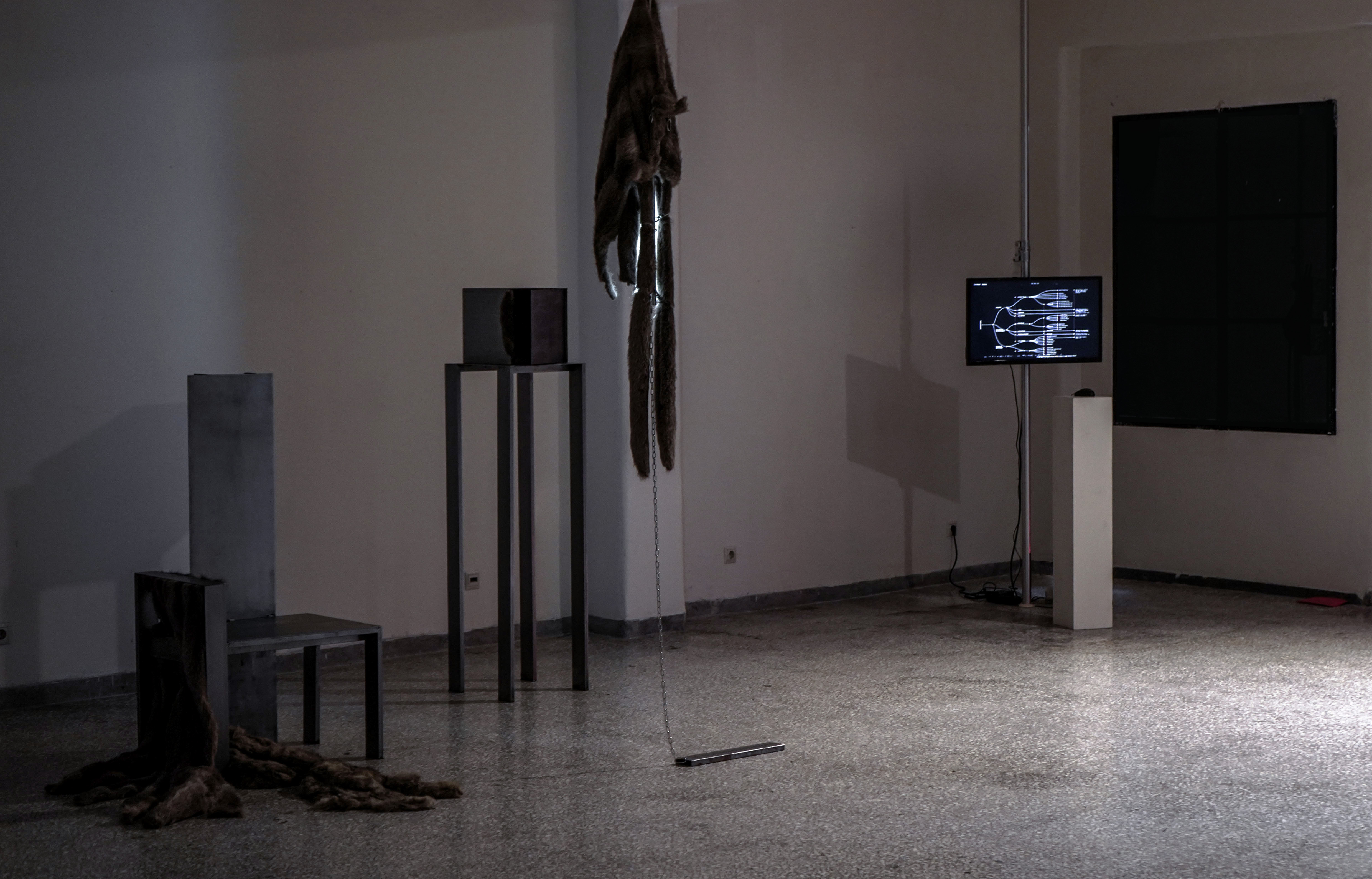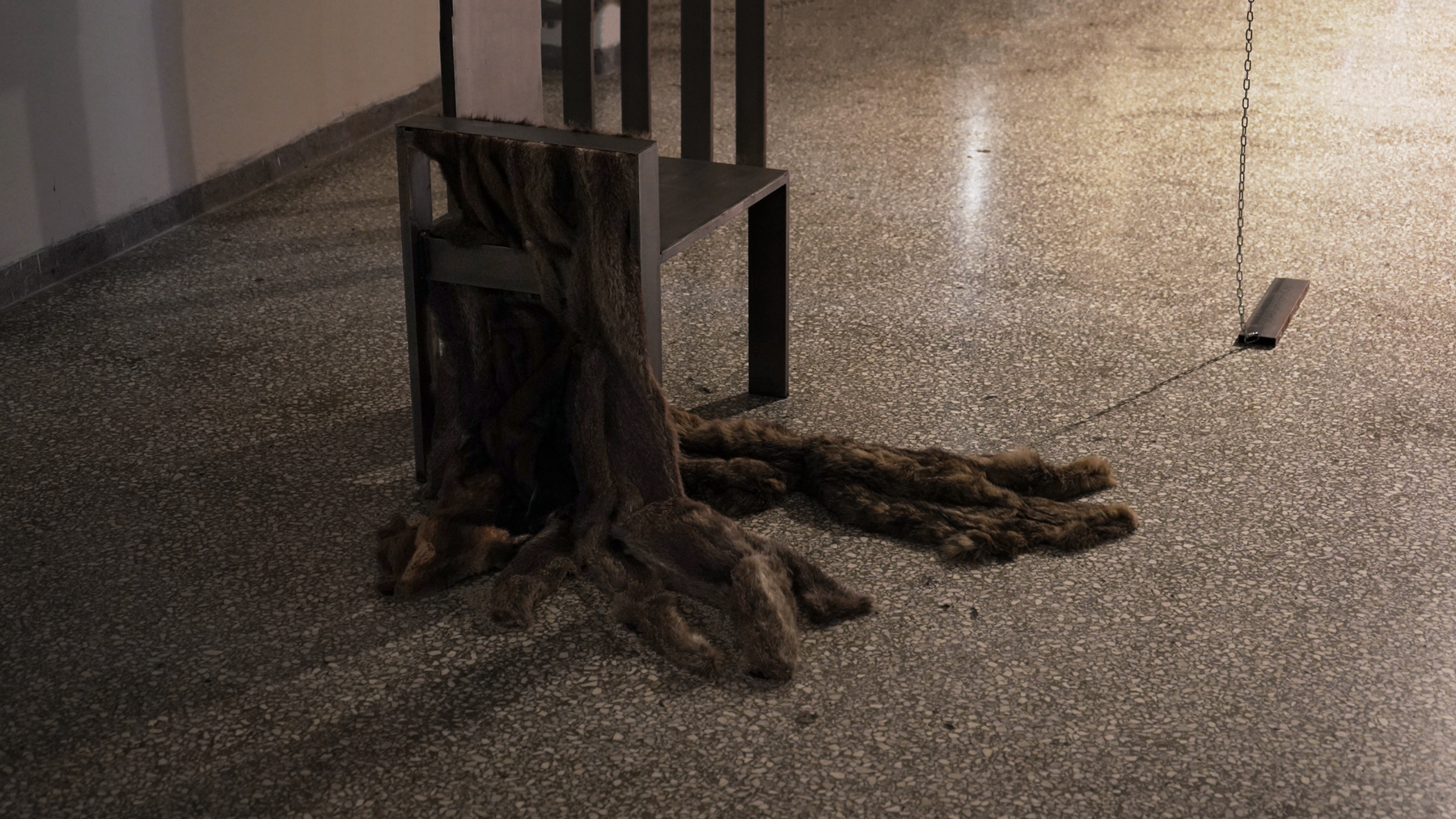



peciesism – like sexism, racism, and other forms of discrimination – is an oppressive belief system in which those with power draw boundaries to justify using or excluding their fellow beings who are less powerful. A human-supremacist line of “reasoning” is used to defend treating other living, feeling beings like research tools, fabric, toys, or even food ingredients – even though they share our capacity for pain, hunger, fear, thirst, love, joy, and loneliness and have as much interest in freedom and staying alive as humans do.’1
Αnimal Kingdom as Τhis abundance, characterising modern western civilization, has been traditionally founded on the subjection and vassalage of other beings. The exploitation of animals and humans (assuming its cruelest form in slavery), both of which still survive today, serve as illustruous examples.2 As Baudrillard stresses, ‘‘We have made of them [that is, of animals] a racially inferior world, no longer even worthy of our justice, but only of our affection and social charity, no longer worthy of punishment and of death, but only of experimentation and extermination.’3
Given this theoretical framework, the project consists of three chapters regarding animal abuse, visually translated into three objects. The visual representations of these objects and the gesturing in which they invite, formulate an imitation of the processes of human cruelty against animals. The factory:The factory incarnates in the clearest way the human abuse over animals. According to the United Nations, 77 billion land animals are slaughtered each year in intensive animal farming as being part of the expendable industrial livestock.4 Animals are turned into machines producing more meat, milk or eggs than they naturally would. In order to achieve that, we even genetically manipulate them. The case of pigs, genetically engineered to grow faster and produce more meat with less feed, is exemplary.5 The full effect of similar genetic modifications in large-scale breeding programs cannot be predicted.6 We have downscaled animals in the category of an object: we produce them in factories, thus rendering impossible their physical reproduction. We call them by numbers (similar to inmates of concentration camps), force them to live under horrible circumstances and consider them as inputs and outputs of an assembly line, where everything must come out as a product The effect of the above is detrimental on the mental health of animals. Animals on factory farms have been observed to suffer from severe stress and depression because of the conditions they are forced to live in. They get severe diseases connected to stress and eventually develop self-injurious behavior.7 Τhe Vault:The vault refers to the exploitation of animal species bluntly for social status. This often translates into expensive clothing and accessories (exotic skin, fur, feathers), with this trade being illegal and the animals suffering abuse or growing in captivity only to be killed.
Animals are seen as trophies, on the one hand carrying economic value, on the other serving for social or entertainment purposes. Hunting and collecting wild animals partakes in this kind of exploitation . This cruelty is practiced even (or especially) by people with great social influence. Suffice to mention that Trump’s son habitually hunts endangered species.10The slaughterhouse: The slaughterhouse points to the raw violence that we knowingly exert on animals, namely torturing and abusing. Simple or gross neglect, intentional abuse, animal hoarding, organized or sexual assault are manifestations of that violence.11
In the case of experiments including them, animals are legally poisoned, deprived of food, water, or sleep, subjected to psychological distress, deliberately infected with diseases, subjected to brain damage, paralysed, exposed to skin or eye irritants, burned, gassed, force-fed, electrocuted and killed.12 It is also to be mentioned that this kind of violence is used as well in the entertainment industry (angling, bullfighting, circuses, zoos, horse racing, to name a few).
Research and writing by Un.Processed Realities
Text editing by John Sklavounos
*All the furs were donated especially for this project / Non toxic substances or glues were used for the construction / All the materials will be re-used in next project
Αnimal Kingdom as Τhis abundance, characterising modern western civilization, has been traditionally founded on the subjection and vassalage of other beings. The exploitation of animals and humans (assuming its cruelest form in slavery), both of which still survive today, serve as illustruous examples.2 As Baudrillard stresses, ‘‘We have made of them [that is, of animals] a racially inferior world, no longer even worthy of our justice, but only of our affection and social charity, no longer worthy of punishment and of death, but only of experimentation and extermination.’3
Given this theoretical framework, the project consists of three chapters regarding animal abuse, visually translated into three objects. The visual representations of these objects and the gesturing in which they invite, formulate an imitation of the processes of human cruelty against animals. The factory:The factory incarnates in the clearest way the human abuse over animals. According to the United Nations, 77 billion land animals are slaughtered each year in intensive animal farming as being part of the expendable industrial livestock.4 Animals are turned into machines producing more meat, milk or eggs than they naturally would. In order to achieve that, we even genetically manipulate them. The case of pigs, genetically engineered to grow faster and produce more meat with less feed, is exemplary.5 The full effect of similar genetic modifications in large-scale breeding programs cannot be predicted.6 We have downscaled animals in the category of an object: we produce them in factories, thus rendering impossible their physical reproduction. We call them by numbers (similar to inmates of concentration camps), force them to live under horrible circumstances and consider them as inputs and outputs of an assembly line, where everything must come out as a product The effect of the above is detrimental on the mental health of animals. Animals on factory farms have been observed to suffer from severe stress and depression because of the conditions they are forced to live in. They get severe diseases connected to stress and eventually develop self-injurious behavior.7 Τhe Vault:The vault refers to the exploitation of animal species bluntly for social status. This often translates into expensive clothing and accessories (exotic skin, fur, feathers), with this trade being illegal and the animals suffering abuse or growing in captivity only to be killed.
Animals are seen as trophies, on the one hand carrying economic value, on the other serving for social or entertainment purposes. Hunting and collecting wild animals partakes in this kind of exploitation . This cruelty is practiced even (or especially) by people with great social influence. Suffice to mention that Trump’s son habitually hunts endangered species.10The slaughterhouse: The slaughterhouse points to the raw violence that we knowingly exert on animals, namely torturing and abusing. Simple or gross neglect, intentional abuse, animal hoarding, organized or sexual assault are manifestations of that violence.11
In the case of experiments including them, animals are legally poisoned, deprived of food, water, or sleep, subjected to psychological distress, deliberately infected with diseases, subjected to brain damage, paralysed, exposed to skin or eye irritants, burned, gassed, force-fed, electrocuted and killed.12 It is also to be mentioned that this kind of violence is used as well in the entertainment industry (angling, bullfighting, circuses, zoos, horse racing, to name a few).
Research and writing by Un.Processed Realities
Text editing by John Sklavounos
*All the furs were donated especially for this project / Non toxic substances or glues were used for the construction / All the materials will be re-used in next project